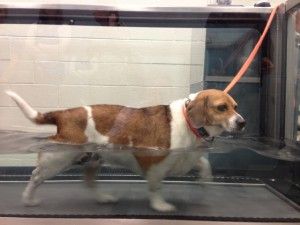Guest post from Dr. Patrick Mahaney, VMD
If you’ve read my PetSafe article Pet Obesity: The #1 Nutritional Disease in Pets, you should have a better understanding of the epidemic nature of this extremely common, potentially fatal, and completely preventable pet health problem. In the article, I taught you how determine your pet’s Body Condition Score (BCS). If you’ve scored your canine or feline as being Stout or Obese, then how do you promote healthy weight loss?
- Schedule an examination with your veterinarian
- Enforce calorie restriction and portion control
- Reduce processed pet foods and increase whole foods
- Feed more frequently
- Commit to daily exercise
Of course, all of the above are merely recommendations for weight loss. Such suggestions won’t work if they are not put into effect on a consistent basis.
Case Study: Mabel
In the fall of 2012, I had the pleasure of meeting a dog having what I feel is one of the greatest success stories of canine weight loss. Mabel is a Beagle who was gradually being fed to death by her owner before being given up for adoption to the Young-Williams Animal Center.
Vet Exam Mabel’s need for medical evaluation and weight-loss was obvious, so she was brought to the University of Tennessee College of Veterinary Science and became a patient of veterinary nutritionist Dr. Angela Witzel. Witzel states “She was the fattest dog I had ever seen." “After walking a mere 25 yards, she would just collapse and for the first few weeks, we had to cart her back and forth from the treatment rooms.” Witzel determined that Mabel’s ideal weight should be between 22-23 pounds. To ensure that she was healthy enough to sustain the rigors of a weight loss program and to evaluate her for other illnesses that could contribute to injury during exercise, Maybel underwent a series of diagnostic tests (blood and urine testing, x-rays, etc.).
Daily Exercise When I met Mabel, she was already well into her weight loss and had noticeably slimmed down. I witnessed her perseverance in striding through the warm water (which provides buoyancy and increases circulation all around the body) in the PetSafe’s Vet Therapy Underwater Treadmill, which Mabel reportedly used twice daily upwards of three days a week.  It was a remarkable site to witness Mabel striding along with a seeming grin of contentment on her face. She was truly happy while exercising, which is one of the goals of engaging in physical activity in the first place (i.e. mood enhancing neurochemicals are released). After all, who wants to sit around in pain and be immobile, which leads to the potential development of behavioral changes including anxiety, aggression, and depression.
It was a remarkable site to witness Mabel striding along with a seeming grin of contentment on her face. She was truly happy while exercising, which is one of the goals of engaging in physical activity in the first place (i.e. mood enhancing neurochemicals are released). After all, who wants to sit around in pain and be immobile, which leads to the potential development of behavioral changes including anxiety, aggression, and depression.
Diet Changes Besides exercise, Mabel was also on a calorie restricted diet to promote her weight loss and support to her musculoskeletal system (muscles, joints, ligaments, tendons, etc.), which was now being asked to work harder than ever to achieve a healthier state.
Obesity-Related Medical Conditions Unfortunately, Mabel’s morbid obesity put significant stress on her joints and compromised the health of one of her stifle (knees) joints, so she subsequently developed a cranial cruciate ligament tear that needed to be medically treated as part of her ongoing weight-loss program. Such injuries are common in many pets that are overweight and engaging activities, from normal walking around the home or more rigorous exercise sessions. 
As Mabel was already being regularly cared for by U of T’s Physical Rehabilitation and Sports Medicine service, her activity could be adjusted to be appropriate for her specific needs and she could also receive beneficial therapies like massage, physical rehabilitation, acupuncture, and more.
For my patients that are active and either overweight or leaning towards the geriatric years (seven years and older), I recommend supporting the joints through regular nutraceutical supplementation, including fish oil based omega-3 fatty acids (nature’s anti-inflammatory) and glucosamine/chondroitin (which provide the building blocks for healthier joint surfaces and fluid).
As I am an active, 40-year-old adult with a history of chronic pain from intervertebral disc disease (IVDD) and arthritis, I take the same approach to managing my own comfort levels during activity and daily life so that my need to take anti-inflammatory and other pain relieving medications is minimized.
I hope that you can take these weight loss recommendations and apply them to your own pets to promote a healthier BCS and better quality of life. Mabel is a great example of the goals that can be achieved with consistent dedication to living a healthier lifestyle. I wish her ongoing success.





